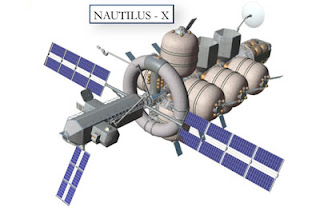Revolutionary Thinking in Nuclear Rockets
A few months ago I started talking to Jim Dewar about his latest book, which I reviewed in August. My suggestion to him was that he needs to write a better introduction that assumes the technical knowledge of rocketry but not the nuclear industry. He took on the task and recruited a number of people to serve as reviewers, myself included. So far, it hasn't been published anywhere, but he's given me a copy and invited me to publish it here.
To avoid confusion, I've put it on my website:
A Technical and Economic Introduction to Nuclear Rockets
It's long but divided into sections, and I think Dewar has done a great job, so check it out.
Jim tells me he would like to hear feedback.
To avoid confusion, I've put it on my website:
A Technical and Economic Introduction to Nuclear Rockets
It's long but divided into sections, and I think Dewar has done a great job, so check it out.
Jim tells me he would like to hear feedback.


I found the article fascinating, even though it was a touch over my level of education. Would the non-proliferation or atmospheric test ban treaties prohibit this from being developed?
ReplyDeleteI understand the minimal radiation impact, but selling something based on the actual science can be tricky.
What's the next step for Mr. Dewar?
I think there should be some discussion of the advantages and disadvantages of liquid and gas core nuclear rockets, to justify the concentration on solid core systems. Not a lot -- a couple of lines, without equations, would be sufficient.
ReplyDelete--mike shupp
My compliments on the brevity of the document. I have long thought that nuclear thermal propulsion would be very useful, but I have little patience with long screeds-- particularly when they look like long shots. Still, this could use an abstract to summarize it too.
ReplyDeleteI am a little concerned about how much he seems to have settled on a specific design for nuclear propulsion technology. A specific core (the B-4), a specific launch method (drop from a cargo plane over the ocean), and a specific booster (solid). It's good to have such a specific example of how to use nuclear propulsion for earth launch to orbit, but I would prefer it if he were to say repeatedly that this is just one example and that the various details are NOT set in stone.
Finally, as much as I like nuclear technology, it is a bit much to say that this is THE way to eliminate "mission-itus" and all the associated expenses. I'm rather doubt that this is the only way to reduce the cost of access to space and that it is immune to mission-itus. I do agree that some sort of nuclear propulsion is needed for realistically settling the solar system, but I think that chemically fueled rockets could be good enough for earth to orbit. At least I think that it is still open to debate.
Don't forget the DUMBO reactor design that the NERVA Program looked at.
ReplyDeleteIIRC, DUMBO had a few advantages over Solid Core designs the NERVA program focused on.
1st, the reactor was designed from the PoV of the working fluid in order to maximize work and minimize flow drag. And if you don't think that's important, go tell it to the XFV-12.
2nd, the fuel encapsulation was designed to extremity wear resistant, to the point that the there was not any detected residual radioactive elements in the outflow (after several hours of run time).
3rd, T/W was such that it could be used as a 1st stage engine for ground launch.
Donald Kingsbury (McGill Prof and SF writer, yes *that* Kingsbury) put out a monogram on the tech in the pre-internet days around the time his book 'The Moon Goddess and the Son' came out (wish I could find my copy).
DUMBO died of accounting before Politics killed NERVA. OBM (or one of the equivalents) required, as a cost savings measure, that for testing DUMBO it must use the same, already built, rocket nozzle as NERVA. Since it was totally incompatible design, that was the killing blow to moving forward with the tests.